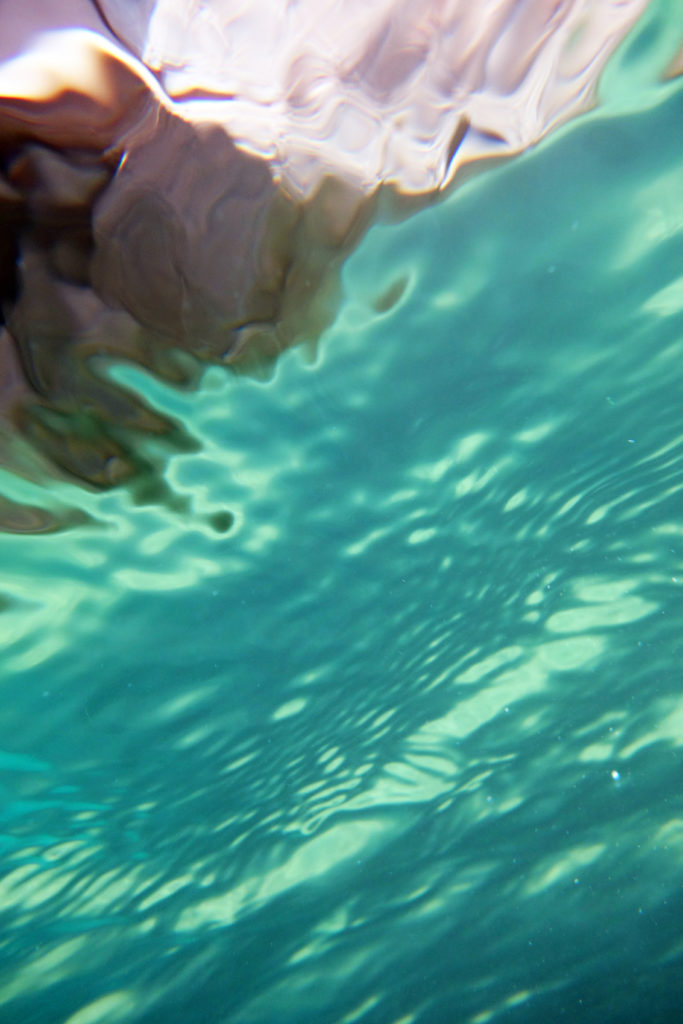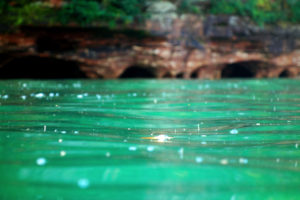
“Painting” by Bazile, a Lakewolves Program founding member
Underwater photography is a way for me to give the Lake a voice for others to interpret. The Lake speaks to me and I want others to hear it too. – A Zaaga’igan Ma’iinganag/Lakewolves Program founding member
Watch a short YouTube slide show of images from Under the Surface and Lakewolves.
[yotuwp type=”videos” id=”8vB2AY_ebDA” ]
A unique program in northern Wisconsin uses the healing value and inspiration of spending time in water to aid youths facing significant mental health challenges and to educate middle and high school students. Thanks to funding from Wisconsin Sea Grant, the program is expanding its reach, and connecting teens with freshwater science.
Begun in 2012, the Under the Surface project has been supported by Sea Grant since 2016. The therapeutic program was created when Toben Lafrancois, an aquatic scientist at Northland College in Ashland, Wisconsin, began working with a successful photography program of Northwest Passage, a residential treatment center in northern Wisconsin. Under the Surface was born from this collaboration, taking Northwest Passage clients out to lakes, rivers and Lake Superior on underwater photo excursions. The adventure, art and exploration are part of comprehensive treatment programming.
An extension of the program called Lakewolves (or Zaaga’igan Ma’iinganag in Ojibwe) reaches students from Bayfield, connecting outings in nearby waters to personal growth, aquatic science and cultural expression.
Lafrancois said Under the Surface is the only program of its kind in the world. “We’ve spoken with a worldwide audience through the Blue Mind Network and haven’t heard anybody say they’ve got anything like this at all,” he said.
The current iteration of Under the Surface is reaching out to teachers, community leaders and treatment staff, although the COVID-19 pandemic has delayed some aspects of this effort.
“A lot of the things I had planned have been shifted around,” Lafrancois said. “But the focus of the core program is the same. It’s all about the kids, their experience and well-being, and then sharing their photographs. We are taking out a couple of teachers and we’re taking out Northwest Passage folks who are involved in the clinical aspects of treatment so they will understand the experiences the kids are having.” One person Lafrancois works closely with at Northwest Passage is Ian Karl, experiential programming coordinator.
Lafrancois also hopes to involve tribal elders in the Lakewolves program through involvement in exhibitions and outings, if possible.
The coronavirus has also changed how the staff interact with the teens. Lafrancois explained that because of the nature of the issues the children from Northwest Passage are dealing with, social distancing has always been part of the program. There’s also the need not to disturb each other’s photographs. However, “The staff wear N95 masks whenever we talk to the kids. We are very careful about leaning over to look at photographs,” Lafrancois said.
While snorkeling, staff members protect the backs of their necks from sunburn by wearing buffs. They pull these scarves over their noses and mouths when talking with participants in the water. They also transport the participants in two vans, versus one, to increase distance between the kids. Lafrancois explained this is more expensive but is worth it for safety.
Under the Surface connects the youths with scientific topics in an indirect way. “It’s like jazz,” Lafrancois explained. “We know our scales and then we get to the site and we watch what the kids are doing and the things they get excited about. We’re prepared for what they might ask, and we go with that. Then we take their curiosity and their photographs and turn it into research projects for them. The kind of project that comes out of it depends on where they are at.”
With Lakewolves, the scientific connection can be more direct. Lafrancois works with Bayfield High School teacher Rick Erickson to weave the students’ photography into ongoing research projects – “Either things I’m doing or colleagues around the Bayfield Peninsula are doing. That helps the kids feel connected to that research and it allows us to have good conversations on the rainy and snowy days after the photography is done. We talk about why these things matter locally,” Lafrancois said.
Success in Under the Surface is hard to measure because of the array of reasons why teens end up at the treatment center. Many have histories of anxiety, depression and trauma. Lafrancois said the ideal is to have the kids require a lower level of care than they needed before treatment.

“Intergalactic Treasure” by Sadaf Nasir, Under the Surface Program participant
However, the program has had many success stories and Lafancois offered one. Sadaf Nasir is currently a college student at Marquette University, double majoring in biomedical sciences and psychology. “She directly associates underwater photography with locking in her treatment outcomes. She’ll tell you that being in the water saved her life,” Lafancois said.
Nasir is planning to attend graduate school. Lafrancois said she wants to continue studying psychology to help measure outcomes from programs like Under the Surface.
Lafranois also said many graduates of the Lakewolves program have gone on to serve Lake Superior in various ways, including working for the National Park Service in the Apostle Islands National Lakeshore. All of the founding members of the program have continued their education after high school.
Lafrancois and Karl are thankful for Sea Grant support but Lafrancois said maintaining the program is a struggle. “It’s been an amazing journey – seeing the program become an institution. We plan on trying to keep it that way,” he said.
Under the Surface is also supported by Northwest Passage, Bayfield High School and the National Park Service.





